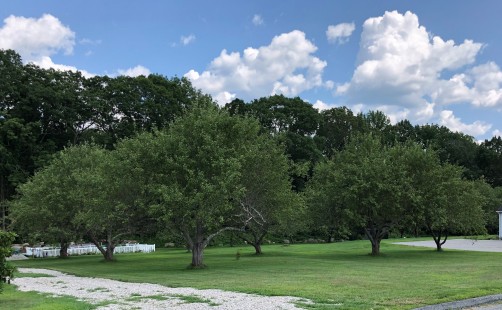Newswise — March 16, 2022 - Abandoned orchards can be a beautiful sight. The neatly lined rows of trees often stick around for decades. Although beautiful, it may not be as easy to tell that there could be trouble below the surface. Harsh, toxic pesticides used in the past can linger in the soil. They might even make it to the groundwater and nearby wells.
Those are the findings of new research into the source of arsenic contamination in drinking water. “Better understanding of potential sources and conditions that relate to arsenic contamination improves our ability to identify contaminated wells and areas, and prevents people from unknowingly consuming contaminated water,” says Mark Higgins, a researcher at the University of Connecticut.
The new study was published in the Journal of Environmental Quality, a publication of the American Society of Agronomy, Crop Science Society of America, and Soil Science Society of America.
As part of the study, Higgins’ team started by collecting historical information on orchards in Connecticut. The state once hosted over 47,000 orchards. But the researchers focused on 189 former orchards and 114 domestic wells within their study area in the Northeastern corner of the state.
Arsenic, a cancer-causing chemical, can leach out naturally from certain rocks. It can also come from man-made sources, like pesticides. Pesticides were often applied to fruit trees in orchards. It was never clear, though, whether this arsenic could make its way to groundwater and pollute wells. Legislature to prevent usage wasn’t put into by the EPA until 1988, but it generally was not commonly used after the early 1950s.
“In our study, wells containing arsenic tend to be much closer to historic orchards and have a lot more of these orchards in their vicinity than wells that did not have arsenic,” says Higgins. Twelve percent of the wells in this study exceeded safe drinking water limits for the contaminant.
The arsenic found in pesticides is not a new discovery. Scientists have long debated whether the arsenic could get into groundwater. Many researchers thought the soil could keep the arsenic in place. And it’s true that arsenic can bind tightly to soil and stay there, but contaminated soil comes with many consequences. Higgins’ team found very high concentrations of arsenic in some of the soils they tested. “It is a health concern when people are exposed to arsenic through inhalation or growing vegetables in these soils,” says Higgins.
As part of the study using simulated rainfall tests, the scientists found that arsenic could leach into rainwater - the first step toward making it into wells. So, soil might not always hold on to arsenic strongly enough. Substantial changes to the soil in places like abandoned orchards can also make arsenic more likely to move deeper down. These include adding fertilizers and physically moving the soil around.
The widespread use of pesticides and the sheer number of orchards make the issue very difficult to process for those who rely on wells. “There isn't one little contaminated piece of land that we can focus on to determine if it is a source of contamination, there can be tens or hundreds within in a relatively small study area, as our study indicates,” says Higgins. “This all makes it more difficult to be able to say ‘This area definitely has contaminated water’ or vice versa. In many cases, wells within 100 feet of each other have completely different water quality.”
Still, Higgins’ advice to those living in vulnerable areas is simple. “The number one thing is to test your water regularly,” he says. “Long-term exposure is a bigger concern at these concentrations, so it is important to test your water sooner rather than later.”
This research was supported in part by the USDA-NIFA Multistate Hatch Fund, Projects W-3045 & 4045; Geological Society of America Student Research Fund; UCONN Department of Natural Resources and the Environment; UCONN Department of Geosciences.
MEDIA CONTACT
Register for reporter access to contact detailsArticle Multimedia

Credit: Meredith Metcalf
Caption: Researcher Mark Higgins measuring arsenic and lead levels in soils. Fruit trees planted in the past with pesticides (containing arsenic and lead) can stay in soil for decades and could contaminate groundwater.

Credit: Mark Higgins
Caption: Apple trees planted between 1934 and 1951 on a former commercial orchard in central Connecticut. Arsenic pesticides were commonly applied and persist at high concentrations throughout the soils.

Credit: Meredith Metcalf
Caption: Apple trees planted around 1970 on a former commercial orchard in eastern Connecticut that has since redeveloped into a residential neighborhood. These soils did not have elevated arsenic or lead as the trees were planted more than a decade after farms stopped using lead-arsenate pesticides.

Credit: Mark Higgins
Caption: Abandoned spray applicator truck used to apply lead-arsenate pesticides to fruit trees prior to the 1950s found on former commercial orchard land. The interior surface of the open wooden tank showed very high levels of arsenic and lead even decades after being exposed to the weather.



